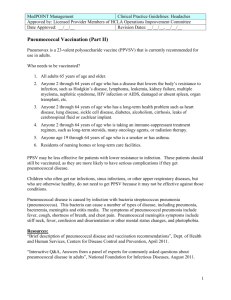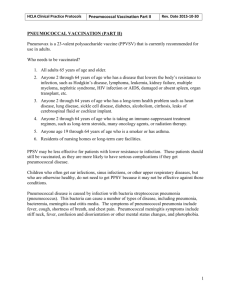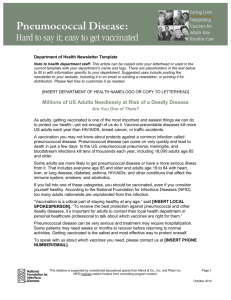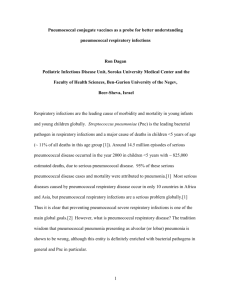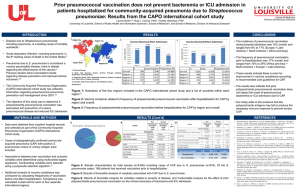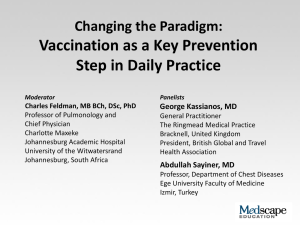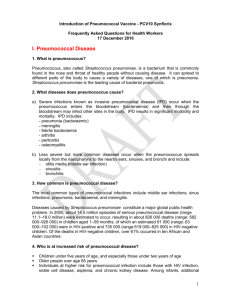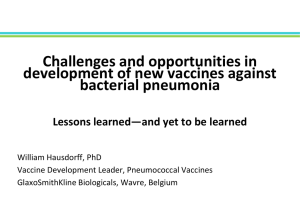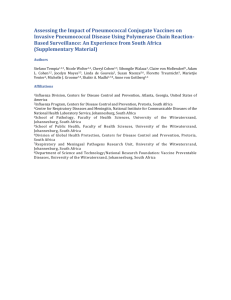update on pneumococcal disease serotypes towards the
advertisement
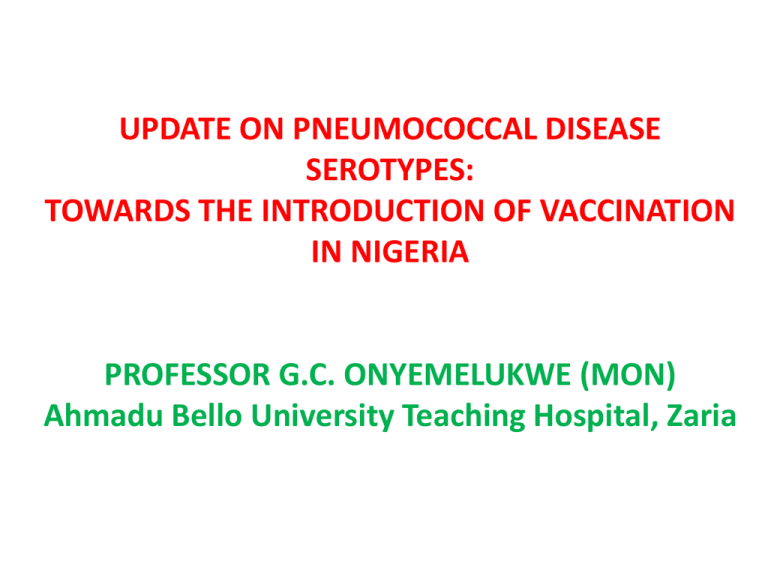
UPDATE ON PNEUMOCOCCAL DISEASE SEROTYPES: TOWARDS THE INTRODUCTION OF VACCINATION IN NIGERIA PROFESSOR G.C. ONYEMELUKWE (MON) Ahmadu Bello University Teaching Hospital, Zaria EXPERT PANEL MEETING ABUJA JUNE 16TH 2010 ON INVASIVE PNEUMOCOCCAL DISEASE (IPD) 1. Honourable Minister of Health, Prof. Onyebuchi Christian Chukwu Represented by Dr. Michael Anibueze, Director Public Health FMoH 2. Executive Secretary/CEO NPHCDA, Dr. Mohammed Ali pate Represented by Dr. E. Abanida, Director, Disease Control and Immunization 3. Prof. G.C Onyemelukwe MON Professor of Medicine and Immunology Member National Certification Committee (NCC) on Polio Eradication 4. Dr. Amgad Gamil Regional Medical Director; Vaccines Pfizer, Africa and Middle East Region 5. Prof William Ogala Professor of Paediatrics and Immediate Past President, Paediatric Association of Nigeria (PAN) 6. Prof. Alice Nte Represented by Dr. Yaguo Ide, University of Port Harcourt Teaching Hospital 7. Prof. A.G Falade Professor of Paediatrics Represented by Dr. Regina Oladokun, University College Hospital, Ibadan 8. Dr. U. Nnebe – Agumadu Paediatrician, University of Abuja Member HERFON Committee on Non-Communicable Diseases 9. Dr. Abdulrazaq G. Habib Aminu Kano Teaching Hospital, Kano President, Nigeria infectious Diseases Society 10. Dr. Stephen Obaro Associate Professor of infectious Diseases Michigan State University, USA 11. Dr. Beckie Tagbo Institute of Child Health, University of Nigeria Teaching Hospital, Enugu Member, PAN Immunization Committee 12. Dr. Adejumoke Ayede Peadiatrician, University College Hospital, Ibadan 13. Dr. Kodjoh Soroh Medical Director, Pfizer NEAR 14. Dr. Wadzani Gashau Chairman, National Teaching Working Group (TWG), Antiretroviral Treatment WORLD WIDE DISTRIBUTION OF PNEUMOCOCCAL DISEASE. Brien K O et al. Lancet 2009; 347:893-902 PNEUMOCOCCAL BUBBLE OF DEATHS IN CHILDREN < 5 YEARS OF AGE. Brien K O et al. Lancet 2009; 347:893-902 Numbers of cases of disease by regions • Syndrome Global AFRO PAHO EMRO EURO SEARO WPRO • Pneumonia 13.8m 3.81m 648k 1.45m 238K 5.33m 2.34m • Meningitis 103k 43k 9500 9700 3300 24k 13k • NonP-NonM 538k 215k 55k 51k 19k 122k 76k • Total 14.5m 4.06m 713k 1.51m 260k 5.48m 2.43k JUSTIFICATION Director General (WHO) Dr. Margaret Chan (2009), Pneumonia and Malaria kill More Children. pneumonia, a “Forgotten Disease “ 2. MDG 4- Child and Maternal mortality reduction by (2015) 3. Global burden – India 27% China 17% Nigerian 5% 4. 7million Nigerians with IPD – 380/100,000 mortality 5. 57% Pneumococcal deaths in Africa 6. Nigeria in Pneumococcal belt of Africa with high child and adult mortality despite antibiotics 1. Pneumococcal Global Serotype Project (< 5 years age) 1980 – 2007. Johnson et al 2010 Justification: 800,000 children die per year * IPD > 90% developing countries (Africa, Asia, Latin America). * Findings 1. Six to eleven serotypes cause more than 70% IPD 2. Seven commonest 1,5,6A,6B, 14, 19F, 23F. 3. Serotype global ranking 14, 6B, 1, 23F, 5, 19F, 6A, 19A, 9V, 18C, 2, 4, 7F, 12F, 3, 12A. 8, 46, 15B, 45 4. Africa 14, 1,5, 23F, 19F, 3, 6B 5. 19A most common antibiotic resistance Pneumococcal Conjugate Vaccines (PCV) Capsular polysaccharide + CRM197 = PCV 1. PCV 7 (4,6B, 9V, 14, 18C, 19F, 23F) 2. PCV 10 (Addition: 1, 5, 7F) 3. PCV 13 (Addition: 3, 6A, 19A) - Conjugate vaccine immunogenic in 2 months of age - Serotype specific efficacy after 4th dose - Vaccine schedule: 2, 4, 6, months of age, 4th dose at 15 months (USA) - Protects against meningitis, pneumonia, bacteremia, otitis media. Black et al., 2002. UNITED KINGDOM PCV HISTORY 2002 PCV available, recommended for at risk groups under 2 years 2003 PCV recommended for > 65 years old 2004 PCV for at risk children under 5 years of age 2006 PCV added to routine childhood immunization program POST LICENSE SURVEILLANCE (USA) (as part of universal infant immunization) 1.Reduction in invasive and non-invasive disease due to vaccine serotypes in vaccinated and older unvaccinated population (herd immunity) 2. Fall in rate of penicillin-resistant pneumococcal infections. 3. Small increase in invasive disease due to nonvaccine serotypes (Serotype Replacement) Black et al., 2004; Whitney et al., 2003 UN ASSEMBLY 2010 22ND SEPTEMBER MDG RESOLUTION “Every woman, Every child” – Mr. Ban Ki – moon 1. Saving sixteen million women by 2015, prevent 33 million unwanted pregnancies 2. Protect 120 million children from pneumonia, 88 million from stunting. - Stakeholders – governments, policy makers, donor countries, NGO’s, communities, health workers, business sector, professional associations, academic/ research institutions. Nigerian commitment and endorsement 2010 – 2015 as part of National Health Plan: 20-2020 National Vision 31.63 US dollars per capital, 5% - 15% Federal, State, Local Government Budget. EXPERT COMMITTEE RECOMMENDATION PCV 13 VACCINATION IN NIGERIA 1. Routine immunization of children in Nigeria in a three or four dosage schedule at 6 weeks to 5 years of age 2. Vulnerable population such as sickle cell disease patients at any age 3. HIV infected children and adults 4. Elderly people aged 65 years and above 5. Other major disease conditions such as malignancies, renal failure, nephrotic syndrome, liver cirrhosis, diabetes mellitus, alcoholism and chronic lung diseases CURRENT WORLD STATUS OF PCV USE (JANUARY 2010) introduced into NIP: Universal 41 countries 21% Widespread coverage through private market 2 countries 1% Introduced into NIP: risk 16 countries 8% No current program 134 countries * NIGERIA AFRICA: RESISTANCE OF 375 Isolates of S. Pneumoniae Antibiotics Ivory coast (n = 138) Morocco (n = 98) Senegal Tunisia (n = 58) (n = 58) Total (n = 375) Penicillin G Susceptible 77.5 90.8 38.3 58.6 69.9 Intermediate 18.1 8.2 53.1 34.5 25.6 Resistant 4.3 1 8.6 6.9 4.8 Amoxicillin 3.6 1 3.7 8.6 3.7 Cefotaxime-ceftriaxone 8.8 1 15 3.6 7.3 14.8 5.2 8.6 Chloramphenicol 11 2 CONTINUED Erythromycin 52.6 4.1 11.4 32.8 28 Tetracycline 67.5 12.2 29 34.5 38.3 Rifampicin 5.8 0 0 0 2.1 Cotrimoxazole 60.5 29 19.4 36.4 *Ibadan 14.8 Hospitals Study .. Intermediate resistant to tetracycline and all fully resistant to cotrimoxazole • Jos Study 70.27% sensitive to penicillin 29.72% resistant to penicillin Streptococcus pneumoniae is a gram positive diplococcus See Capsule FOUR MAJOR VIRULENCE FACTORS 1. Capsular polysaccharides – Antiphagocytic and Anti-complement 2. Pneumolysin – Inhibits lymphocyte proliferation and neutrophil chemotaxis 3. IgA1 protease – Cleaves submucosal IgA 4. Autolysin – breaks down peptidoglycan of cell wall to aid release of pneumolysin STREPTOCOCCUS PNEUMONIAE STRUCTURE PNEUMOCOCCAL SEROTYPES IN ZARIA, NORTHERN NIGERIA S T 1 2 MN 23 3 10 2 PN 20 4 12 2 10 1 PP 1 CJ 3 4 5 9 10 11 1 12 15 17 2 18 19 21 2 1 3 5 4 23 25 41 45 46 48 T 2 2 1 1 1 1 51 1 4 2 1 1 70 1 2 1 PID 1 1 BC 8 3 6 T 53 7 28 2 18 1 1 4 2 1 1 1 4 1 3 7 4 1 3 3 5 1 1 3 2 KEY ST=SEROTYPES, MN=MENINGITIS, PN= PNEUMONIA, PP=PRIMARY PERITONITS, CJ=PRIMARY CONJUCTIVITIS, PID= PELVIC INFLAMATORY DISEASE, BC= BACTEREMIA/ANTIGENEMIA, T=TOTAL 20 1 DISRIBUTION OF SEROTYPES IN CHILDREN UNDER 12 YEARS (NUMBER OF CASES - 40) SEROTYPE % 1 47.5 3 17.5 2, 46 , 5 8.3 each 48 2.5 23 2.5 41 2.5 12 2.5 MORTALITY RELATED TO SEROTYPES IN ADULTS AND CHILDREN Serotype Meningitis Case Fatality (%) Pneumonia Case Fatality (%) 1 23 48 20 20 3 10 50 12 41.6 5 2 50 10 20 25 2 50 1 100 45 1 100 2 100 *G.C. ONYEMELUKWE AND B.M. GREENWOOD JOURNAL OF INFECTION (1982) 5, 157-163 CONDITIONS ASSOCIATED WITH PNEUMOCOCCAL DISEASE 1. YOUNG AGE 2. MEASLES – 15 (CHILDREN ) 3. SICKLE CELL DISEASE (3 CHILDREN) 4. PREGNANT WOMEN (6 ADULTS) 5. CIRRHOSIS (2 ADULTS) 6. PERIPARTUM HEART FAILURE (1 ADULT) *G.C. ONYEMELUKWE AND B.M. GREENWOOD JOURNAL OF INFECTION (1982) 5, 157-163 AGES OF SEROTYPED PNEUMOCOCCAL MENINGITIS PATIENTS • Two year study of pneumococcal meningitis with 39% mortality 1. 50% : under 10 years 2. 32.5% : 1- 10 years 3. 17.6% : < 1 year 4. 2.65% < 2 weeks of age Seasonality of infection- All year round Peak periods- Drier Months: January, February, March, April *G.C. ONYEMELUKWE AND B.M. GREENWOOD JOURNAL OF INFECTION (1982) 5, 157-163 Falade et al 2009 (Ibadan) (Clin Infect Dis. 2009 Mar 1;48 Suppl 2:S190-6.) • 2 year hospital surveillance (Age 2-59 months) for pneumonia and meningitis- 1210 cases • 481 (49.8%)- Meningitis • 399 (33%) – Pneumonia • 330 (27.2%) – Bacteremia • 11 out of 23 Streptococcus pneumonia isolates were typed Type 4 – 3 cases Type 5 – 5 cases Type 19 F- 3 cases REFERENCES 1. 2. 3. 4. 5. 6. Onyemelukwe GC, Greenwood BM. Pneumococcal serotypes, epidemiological factors and vaccine strategy in Nigerian Patients. Journal of Infection (1982) 5, 157-163. Onyemelukwe GC. Polymorph function, complement and immunoglobulins in Nigerian patients with pneumococcal infections. Journal of Infection (1983) 7, 118-124 Taqi AM, Onyemelukwe GC. Serotypes and pneumococcal meningitis in Nigerian Children. East African Medical Journal of Infection. (1986) 63 (1), 42-47 Onyemelukwe GC,Leinoen, M MakelaH, Greenwood BM. Response to pneumococcal vaccination in normal and post-infected Nigerians. J Infect. 1985 Sep;11(2):139-44. Falade AG, lagunja IA, Bakare RA, Odekanmi AA, Adegbola RA. Invasive pneumococcal disease in children aged <5 years admitted to 3 urban hospitals in Ibadan, Nigeria. Clin Infect Dis. 2009 Mar 1;48 Suppl 2:S190-6. Bradford D Gessner, Judith E Mueller, Seydou Yaro. African meningitis belt pneumococcal disease epidemiology indicates a need for an effective serotype 1 containing vaccine, including for older children and adults. BMC Infectious Diseases 2010, 10:22. http://www.biomedcentral.com/1471-2334/10/22. cont. REFERENCES . Brien KO, Wolfson L J, Watt JP, Henkle E, Knoll MD, McCall N, Lee E, Mulholland K, Levine OS, Cherian T. Burden of Streptococcus pneumoniae in children younger than five years: global estimates. Lancet 2009; 347:893902. 8. Cutts FT, Zaman SMA, Jaffar S, Levine OS, Oluwalana C, Obaro SK, Leach A, McAdam KP, Biney E, Saaka M, Onwuchekwa U, Yallop F, Pierce NF, Adegbola RA. Efficacy of nine-valent pneumococcal conjugate vaccine against pneumonia and invasive pneumococcal disease in The Gambia: randomized doubleblind, placebo controlled trial. Lancet 2005; 365: 1239-46 9. Traore Y, Tameklo TA, Njanpop-Lafourcade B-E, Lourd M, Yarou S, Niamba D, Drabo A, Mueller JE, Koeck J-L, Gessner BD. Incidence, seasonality, age distribution and mortality of pneumococcal Meningitis in Burkina Faso and Togo. Clin Inf Dis 2009; 48: S181-9 7 cont. References 10. French N, Gordon SB, Mwalukomo T, White SA, Mwafulirwa G, Longwe H, Mwaiponya M, Zijlstra, EE, Molyneux ME, Gilks C. A trial of a 7-valent Pneumococcal Conjugate Vaccine in HIV-Infected Adults. N Engl J Med 2010; 362: 812-22 11. Johnson H.L, Deloria – Knoll M, Levine OS, Stoszek S.K, Hance LF, Reithinger R, Muenz LR, O’Brien KL. Systematic evaluation and serotypes causing invasive pneumococcal disease among children under five: The Pneumococcal Global Serotype Project. PLoS Medicine 2010. 7(10). E1000348. 12. Black S, Shinefield HR, Ling S et al. effectiveness of heptavalent pneumococcal conjugate vaccine in children younger than five years of age for prevention of pneumonia. Pediatr Infect Dis J. 2002, 21; 810 – 815. 13. Black S. et al., Post licensure surveillance for pneumococcal invasive disease after use of heptavalent pneumococcal conjugate vaccine in Northern California Kaiser Permanente. Pediatr Infect Dis J. 2004, 23; 485 – 489. 14. Whitney CG, Farley MM, Hadler J et al Decline in invasive pneumococcal disease after the introduction of protein – polysaccharide conjugate vaccine N. Eng. J. Med 2003, 348 (18); 1737 - 46 REMOVE MY BITING TEETH AND OF THE PNEUMOCOCCUS WITH VACCINATION THANK YOU FOR LISTENING.
